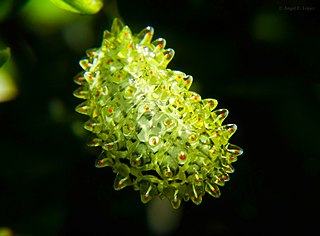Acraga goes is a moth of the family Dalceridae. It is found in Costa Rica, Ecuador, Venezuela, Trinidad, Guyana, Surinam, French Guiana, Colombia, Peru and Brazil. The habitat consists of tropical wet, tropical moist, tropical dry, tropical premontane wet, tropical premontane moist and subtropical dry forests.
Acraga luteola is a moth of the family Dalceridae. It is found in northern Brazil. The habitat probably consists of tropical moist forests.
Acraga neblina is a moth of the family Dalceridae. It is found in Venezuela. The habitat consists of tropical premontane wet and tropical lower montane rain forests, where it is found at high altitudes.

Acraga moorei, the tangerine furry-legs, is a moth of the family Dalceridae. It is found in Venezuela, Colombia, Brazil, Ecuador, Peru, Bolivia, Paraguay and northern Argentina. The habitat consists of tropical wet, tropical moist, tropical premontane wet, tropical premontane moist, tropical lower montane wet, tropical lower montane moist, subtropical wet, subtropical moist, subtropical lower montane moist, subtropical montane wet or rain and warm temperate moist forests.

Acraga coa is a moth of the family Dalceridae. It is found in southern Mexico, Belize, Honduras, Guatemala, El Salvador, Costa Rica and Panama. The habitat consists of tropical wet, tropical moist, tropical premontane wet, tropical premontane rain, tropical lower montane moist, subtropical wet, subtropical moist, subtropical dry and warm temperate wet forests.
Acraga concolor is a moth from the family Dalceridae. It is found in Venezuela, Surinam, French Guiana, northern Brazil, Ecuador, Peru and Bolivia. The habitat consists of tropical moist, tropical wet, tropical premontane rain, tropical premontane wet and subtropical moist forests.
Acraga meridensis is a moth of the family Dalceridae. It is found in the Andes Mountains of Venezuela and Colombia. The habitat probably consists of tropical premontane and lower montane moist or wet forests.
Acraga perbrunnea is a moth of the family Dalceridae. It is found in Colombia and Peru. The habitat consists of tropical lower montane moist and tropical premontane wet forests.
Acraga ochracea is a moth in the family Dalceridae. It was described by Francis Walker in 1855. It is found in southern Brazil, Paraguay and northern Argentina. The habitat consists of tropical premontane moist, subtropical wet, subtropical moist, subtropical dry and warm temperate moist forests.
Dalcerides mesoa is a moth in the family Dalceridae. It was described by Herbert Druce in 1887. It is found in southern Mexico, Guatemala, Costa Rica, Panama, Colombia, Venezuela and Ecuador. The habitat consists of tropical wet, tropical moist, tropical dry, tropical premontane wet, tropical premontane rain, subtropical wet and subtropical dry forests.
Dalcerides rebella is a moth in the family Dalceridae. It was described by Schaus in 1911. It is found in Costa Rica and Ecuador. The habitat consists of tropical wet and premontane wet forests.
Dalcerides bicolor is a moth in the family Dalceridae. It was described by Schaus in 1910. It is found in Costa Rica.
Dalcerides flavetta is a moth in the family Dalceridae. It was described by Schaus in 1905. It is found in Venezuela, Guyana, Surinam, French Guiana, Colombia, Ecuador, Peru, Bolivia and northern Brazil. The habitat consists of tropical wet, tropical moist, tropical premontane wet, tropical premontane moist, subtropical moist and tropical dry forests.

Dalcera abrasa is a moth in the family Dalceridae. It is found in Colombia, Venezuela, Guyana, Surinam, French Guiana, Brazil, Peru and Bolivia. The habitat consists of tropical wet, tropical moist, tropical dry, tropical premontane wet, tropical premontane moist, tropical lower montane moist, subtropical moist, subtropical lower montane moist, warm temperate moist and warm temperate dry forests.
Dalcera canescens is a moth in the family Dalceridae. It is found in Suriname, French Guiana, Brazil and Peru. The habitat consists of tropical moist and tropical premontane wet forests.
Dalcera semirufa is a moth in the family Dalceridae first described by Herbert Druce in 1910. It is found on the western slopes of the Andes Mountains in Colombia. The habitat consists of tropical wet and tropical rain forests.
Minacragides arnacis is a moth in the family Dalceridae. It was described by Harrison Gray Dyar Jr. in 1909. It is found in Colombia, Venezuela, Guyana, Suriname and Peru. The habitat consists of tropical moist, tropical premontane wet and tropical premontane moist forests.
Minonoa elvira is a moth in the family Dalceridae. It was described by Paul Dognin in 1909. It is found in Colombia. The habitat consists of tropical lower montane and premontane wet forests.
Gonaepa actinis is a moth in the family Gelechiidae. It was described by Walsingham in 1915. It is found in New Guinea.
Rhindoma rosapicella is a moth in the family Depressariidae, and the only species in the genus Rhindoma. It was described by August Busck in 1914 and is found in Panama.


